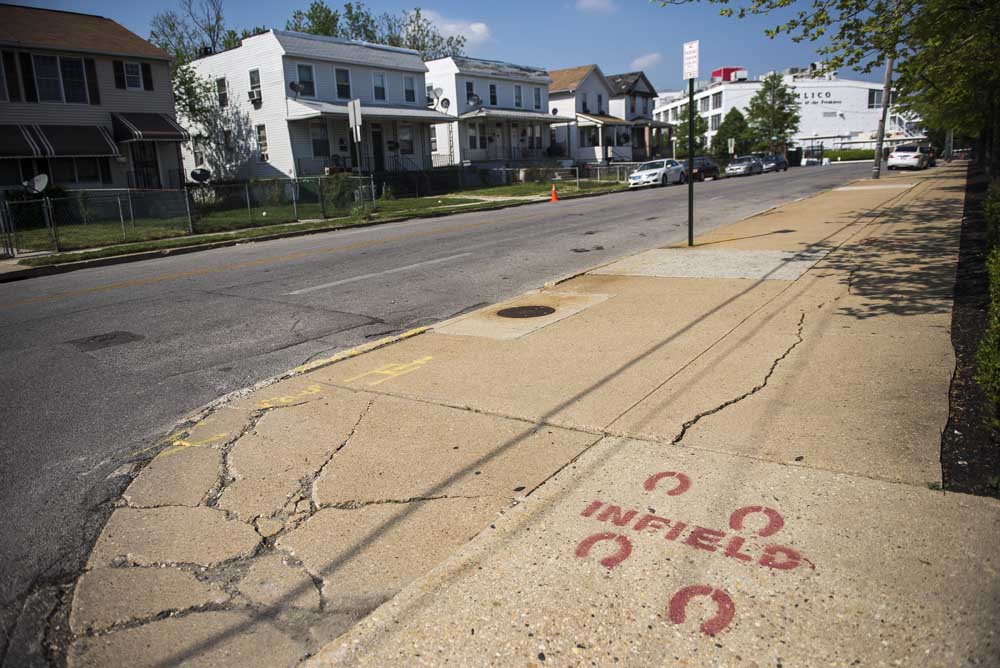A Baltimore neighborhood, wary and still healing, prepares for Preakness
Published 12:00 am Monday, May 11, 2015

- Gabriella Demczuk / The New York TimesRow homes in the Park Heights neighborhood, near the Pimlico Race Course, top right in background, in Baltimore. The Preakness, on Saturday, is always a big party in this neighborhood, but in the aftermath of events surrounding the death while in police custody of Freddie Gray, many people remain on edge.
BALTIMORE —
Soon after Candy Thomas moved into a rowhouse one block from Pimlico Race Course a few weeks ago, a neighbor asked her if she was ready for Preakness Stakes weekend.
The race is always a big party in their Park Heights neighborhood, as more than 100,000 fans and their cars descend on the area, clogging the streets. Music will blare. People will dance. Money will be made.
The front lawn of nearly every home becomes either a parking lot or a pop-up market, perfect for hungry, thirsty fans held captive by the conga lines of traffic. Hot dogs for $5. Bottled water for $3. A bowl of freshly fried chicken, $6.
You could even offer your home’s toilet to fans, for $2, Thomas’ neighbor told her.
“They told me that there’s so many things we can do here that it would be really fun for me and my kids,” said Thomas, a 33-year-old single mother of four who works transporting patients at a hospital. “But I don’t know what to think of it. We’ll see. It’s been a tough couple of weeks.”
A tough couple of weeks for the entire city.
Less than a month ago, Freddie Gray, a 25-year-old black man, was arrested in the Sandtown-Winchester neighborhood, about 4 miles southeast of Pimlico, which sits on the northwest side of the city. Gray fell into a coma while in police custody and later died. Riots and protests followed, including some outside Camden Yards, where in the jittery days after Gray’s death two Baltimore Orioles games were postponed and another was played behind closed doors.
Six police officers have been charged in connection with Gray’s death, and some residents here predicted that those indictments might quell any protests, at least until the trial. But for now, the wounds in the city and in this neighborhood, where the 140th Preakness Stakes will be run on Saturday, are still raw. As race day approaches, many people here remain on edge.
Sometimes sporting events can play a role in healing a city’s wounds, as the baseball games after the attacks of Sept. 11, 2001, did in New York City. But the Preakness doesn’t quite fit that role.
A gigantic banner hanging above the racetrack’s main entrance declares the Preakness to be “the people’s race” and “the people’s party.” But those people, for the most part, aren’t from the largely black community around the track, where just gaining admission to the clubhouse and the grandstand will cost you $25 (much more if you want a seat), and where an infield ticket will set you back $70.
Cory Austin, who lives around the block, said he used to earn money cleaning up after races.
“I’d say a lot of people here have some connection to the track that way,” Austin said. “But most of us don’t know a thing about horse racing and don’t care. We’re just not that kind of people.”
But on race weekend, Austin said, the neighborhood was energized by the party atmosphere and the chance to make a bit of quick money. Asked if that fun might be ruined this year by protesters looking to grab the spotlight, Austin laughed.
“Oh, no, no,” he said. “Do you know how many police there are here that weekend? There’s one every few feet. Nothing’s going to happen here. Not a thing.”
With that police presence, though, comes unease for some residents. Like for Candy Thomas’ daughter Zora, who goes by the name Tinkerbell.
Zora — who is 12 or 13, depending whether you ask her or Thomas — told me that she had met Freddie Gray when she and her mother visited friends at the Gilmore Homes, the housing project where Gray lived. Zora said she considered him a friend.
“He was nice,” she said. “He took me to the ice cream truck almost every day.”
But Zora said that Gray’s death had changed the way she viewed the police. When she sees a police car drive by now, she said, she can feel her heart beating faster.
“Now when I see them, I start thinking, ‘What if they want to fight one of us? What if they want to fight me?’ And that scares me,” she said, while sitting on a swing at the Pimlico Good Neighbor Park, which on Thursday was so strewn with cups, candy wrappers and potato chip bags that it looked as if a trash bag had exploded.
Thomas said that Zora’s distrust of the police made her sad. And even Baltimore’s mayor, Stephanie Rawlings-Blake, admitted on Wednesday that the police and the community had a “fractured relationship.”
That was why the mayor asked the federal Justice Department to investigate any unconstitutional abuse or discrimination on the part of the Police Department. That federal investigation is now underway, but in Park Heights and Sandtown-Winchester and many other neighborhoods, a tense truce between the black community and the police will remain the order of the day for a while.






